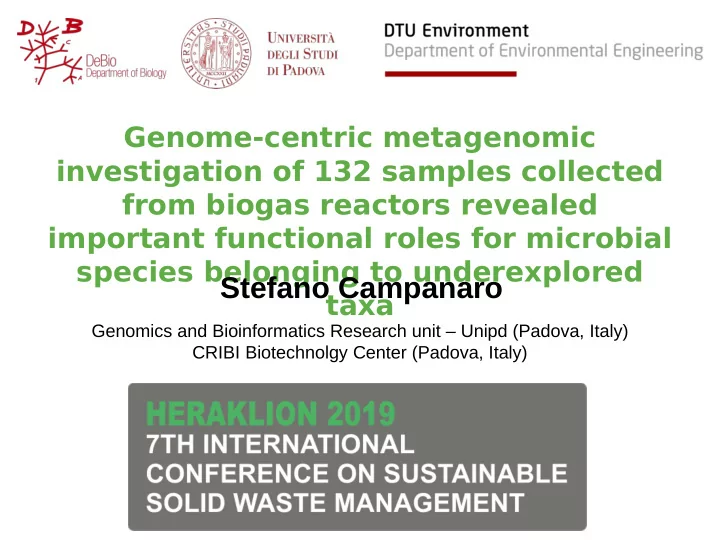

Genome-centric metagenomic investigation of 132 samples collected from biogas reactors revealed important functional roles for microbial species belonging to underexplored Stefano Campanaro taxa Genomics and Bioinformatics Research unit – Unipd (Padova, Italy) CRIBI Biotechnolgy Center (Padova, Italy)
Anaerobic digestion • Similarities in the biochemical process • Complex microbiome and many uncultured • Anaerobic digestion of organic matter is the largest biogenic source of methane on Earth
Anaerobic digestion • Analyzing Anaerobic Digestion considering the microbial composition as a black box is like playing a chess match without knowing the pieces
Functional representation of the AD microbiome Anaerobic digestion food Metagenome Assembled chain Genome (MAG) Functional Gene expression profjles (metatranscriptomics) analysis PG assigned to the functional role in the AD food chain Campanaro et al., Biotech for Biof 2016
Similarities of the microbial communities identifjed in 132 samples Beta diversity of 132 samples revealed temperature and feedstock as main drivers of the microbial community composition
Genomes reconstruction • Importance of reconstructing genomes… • a puzzling view of the subject is making diffjcult to clarify his identity…
Genomes reconstruction • Once reconstructed the full picture… • you can have a more clear view of the subject…
Genomic reconstruction • This is why reconstruction of Metagenome Assembled Genomes (MAGs) can help to defjne microbiome composition an functional roles…
Taxonomy of 1,635 MAGs of the AD microbiome
MiGA database • A dedicated MiGA database was developed for making all the information available to the scientifjc community • were http://microbial-genomes.org/projects/biogasmicrobiome • taxonomy and genomic characteristics of each species
Relative abundance • In most samples these taxa represent 2-3% of the AD microbiome, but in specifjc samples they can represent more than 10% CPR phyla Relative abundance
Metabolic reconstruction Evaluation of their gene content suggests: Ability to synthesize nucleotides (not all the phyla) ; Relevant number of glycoside hydrolases and glycoside transferases (particularly in Candidatus Dojkabacteria and Candidatus Magasanikbacteria) -> degradation of some polymeric substances The presence in some species of the «phosphate acetyltransferase- acetate kinase pathway, involved in the conversion of acetyl-CoA to acetate» -> production of acetate Absence of pathways involved in amino acids and lipids biosynthesis -> proteins and lipids scavenging from the environment Presence of numerous proteases and transaminases -> salvage amino acids from environmental sources
Relative abundance of functional pathways in difgerent reactors • Relative abundance of MAGs associated to the encoded metabolic pathways allowed to estimate the relevance of difgerent pathways in each sample: • (A) methanogenesis • (B) WL-pathway • (C) polysaccharides degradation.
A network of laboratories to study the AD system T o deal with the complexity of this metagenomic study we are forming a network of laboratories from Denmark, Greece, Spain, Germany, China, USA, Canada… …and more collaborations are welcome!
Aknowledgments • Bioenergy group, T echnical University of Denmark: Xinyu Zhu, Adam Kovalovszki, Irini Angelidaki • Genomics and Bioinformatics group , University of Padova: Arianna Basile, Laura Treu • School of Civil & Environmental Engineering, Georgia Institute of T echnology: Kostas Kostantinidis, Luis M. Rodríguez Rojas • Department of Civil Engineering, University of British Columbia: Ryan M Ziels • Soil and Water Resources Institute Hellenic Agricultural Organization DEMETER: Panagiotis Kougias • Center for Biotechnology (CeBiT ec), Bielefeld University: Irena Maus, Andreas Schlüter • Department of Environmental Science and Engineering, Fudan University: Gang
CRIBI Biotechnology Center • CRIBI is an interdepartmental Biotechnology Center located at Padova University • 22 difgerent research groups of 14 difgerent departments • 4 facilities dedicated to research • - Next generation sequencing; • - Proteomics • - Microarrays, real-time PCR, digital PCR • - Peptide synthesis http://www.cribi.unipd.it/ http://www.cribi.unipd.it/ @ CRIBI _ UniPD @ CRIBI _ UniPD
Thank you! Stefano Campanaro Department of Biology, CRIBI Biotechnology Center, University of Padova stefano.campanaro@unipd.it https://sites.google.com/site/stefanocampanaro/ http://genomics.cribi.unipd.it/main/ngs-sequencing-service/b ioinformatics/ @campanarostef
Genome size MAGs genome size according to taxonomic assignment The low completeness associated to MAGs belonging to some phyla suggests that essential gene sets has to be revisited
Recommend
More recommend